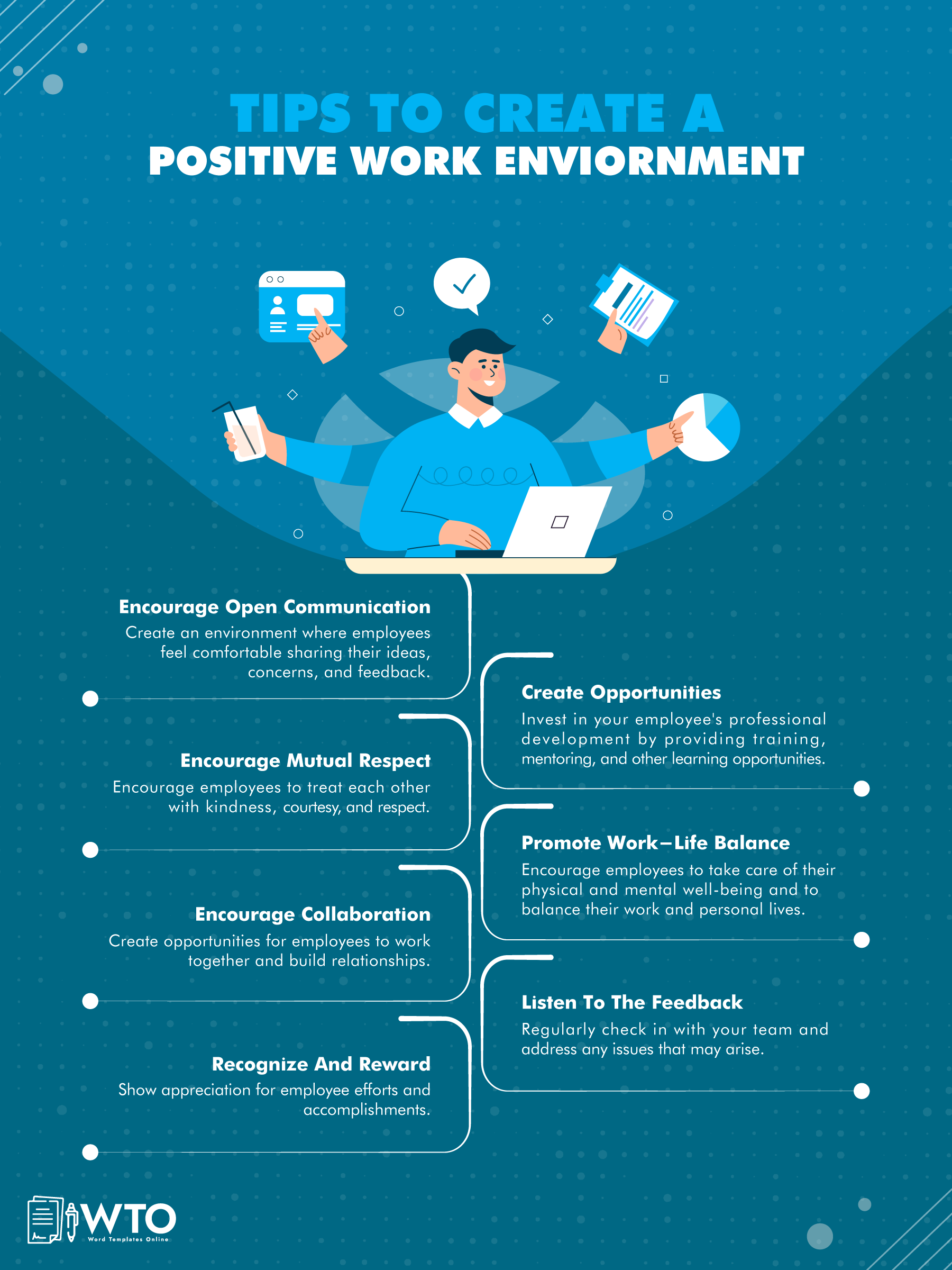A positive work environment is a crucial factor in fostering employee engagement, productivity, and job satisfaction.
It refers to an atmosphere in which employees feel valued, respected, and supported, and where their well-being and contributions are recognized and celebrated. It encourages collaboration, creativity, and growth and is characterized by open communication, mutual trust, and a shared sense of purpose.
In this article, we will explore the importance of this environment and how it can benefit both employees and organizations, along with practical tips for creating and maintaining a positive workplace culture.
What is a Positive Work Environment?
A positive work environment is a workplace culture where employees feel supported, valued, and motivated.
It is characterized by open communication, collaboration, inclusivity, and opportunities for growth and development. In a supportive workplace, employees are empowered to contribute their ideas and opinions, have access to the resources they need to excel in their roles, and are recognized and rewarded for their contributions.
It also promotes work-life balance, employee well-being, and a safe and respectful workplace. It also fosters a sense of engagement, satisfaction, and loyalty among employees, leading to increased productivity, creativity, and overall success for the organization.
Essential Characteristics of Positive Work Environment
A few characteristics are often seen in a company that promotes a positive work culture. Some of these include:
Respect and inclusivity
Employees feel respected, valued, and included regardless of their background, identity, or beliefs. Diversity is embraced, and all employees are treated with fairness and equity in a positive workplace.
Open and honest communication
Employees feel comfortable sharing their opinions with management when they sense a problem, and they must be able to communicate openly with other coworkers to complete their tasks. Effective communication channels are established in a healthy work environment for sharing information, feedback, and updates.
Collaboration and teamwork
Collaboration and teamwork are encouraged and valued in a supportive workplace. Employees work together, share ideas, and support each other in achieving common goals. There is a sense of camaraderie and collaboration, rather than competition or hostility.
Rewards and recognition
A positive workplace acknowledges and appreciates the contributions of employees. Recognition and rewards are provided for a job well done, and employees feel motivated and appreciated for their efforts and achievements.
Supportive leadership
Leaders in a positive workplace are supportive, approachable, and accessible to employees. They provide guidance, mentorship, and support to help employees achieve their goals, and they actively promote a healthy work culture through their actions and behaviors.
Empowerment and autonomy
Employees are empowered to make decisions and take ownership of their work. They have the autonomy to use their skills and creativity to contribute to the organization’s goals and are trusted to do their job without micromanagement.
Growth opportunities
This environment will encourage employees to work on their skills and strengths to perform better in their current roles. It supports the growth and development of employees. Opportunities for learning, training, and career advancement are provided, and employees are encouraged to develop their skills and pursue their career aspirations.
Work and life balance
A positive working environment will promote good work and life balance. You need to recognize that your employees have lives outside of work and want to spend time with their families, pursue hobbies, and see friends. Therefore, they do not want to bring work home with them all the time. If you can promote a good work and life balance, you will find that your employees are well-rested, better prepared to come to work, and more efficient with their tasks.
Workload and resource management
A workplace with a positive environment ensures that employees have manageable workloads and the necessary resources to perform their jobs effectively. Employees are not overwhelmed by excessive work demands.
Employee health and wellness
Employee health and wellness are prioritized in a workplace with a positive environment. Some programs and initiatives promote physical and mental well-being, such as wellness programs, mental health resources, and work-life balance support.
Why is Creating a Positive Work Environment Important?
As an employer, you will see that a healthy environment in the workplace can provide many benefits to your employees, leading to many great benefits for you.
Some of the reasons why you should focus on creating a healthy work environment in your company include the following:
Employee retention and loyalty
A positive workplace atmosphere contributes to higher employee retention rates. Employees who are happy and satisfied with their work environment are more likely to stay with the organization for the long term and be loyal to their employer. This reduces turnover and the associated costs of hiring and training new employees.
Organizational culture and reputation
A positive environment contributes to a positive organizational culture and reputation. A workplace that is known for its positive culture is likely to attract top talent and be viewed positively by customers, clients, and other stakeholders. A positive reputation can enhance an organization’s brand image, competitiveness, and long-term success.
Enhances productivity
A healthy work environment fosters high levels of employee engagement, motivation, and productivity. When employees feel respected, supported, and valued in their workplace, they are more likely to be committed to their work and give their best efforts, leading to increased productivity and better performance.
Collaboration and innovation
A supportive workplace promotes collaboration and teamwork among employees. When employees feel comfortable sharing ideas, working together, and supporting each other, it fosters a culture of innovation and creativity. Employees are more likely to collaborate, share diverse perspectives, and suggest innovative solutions to challenges.
Health and well-being
An employee-centric work environment prioritizes the health and well-being of employees. Employees who feel supported in their well-being, including their physical, mental, and emotional health, are likely to have better job satisfaction, less stress, and improved overall well-being. This can result in fewer absences, lower healthcare costs, and increased morale.
Strategies for Creating Supportive Work Environment
Creating a work environment that is supportive and positive is something that requires a proactive stance from the management and owner of a company. It requires intentional effort and strategies.
Here are some strategies that organizations can implement to create a positive environment:
Improve the onboarding process
Onboarding refers to the process of integrating new employees into the organization, and it plays a significant role in creating a supportive workplace. It sets the tone for new employees’ experiences and helps them feel welcomed, supported, and engaged from the very beginning of their employment.
Therefore, a well-designed and executed onboarding program is essential for any organization to create a positive atmosphere in the workplace.
Improve communication
As an employer, you must develop open communication channels with the staff. This is even more important if you have a remote workforce. Plan various team-building exercises that encourage cooperation and enhanced productivity, whether they are online or in person.
Foster culture of respect and inclusivity
Promote a culture that values diversity, inclusivity, and mutual respect among all employees. This includes creating policies and practices that promote diversity, equity, and inclusion, fostering a respectful and inclusive communication style, and addressing any form of discrimination or harassment promptly and effectively.
Comfortable workplace
Physical comforts in the workplace, such as comfortable ergonomic furniture, a pleasant ambiance, designated break and relaxation areas, proper workspace design, and access to amenities, can greatly impact the overall work environment. A comfortable and well-designed physical environment promotes employees’ well-being, reduces discomfort and distractions, and enhances productivity, contributing to a positive environment where employees feel valued and supported.
Celebrate employee milestones
Your employees will reach more milestones the longer they work for you. It is your goal to monitor and celebrate these milestones. Recognizing and celebrating employee milestones, achievements, accomplishments, and personal occasions is crucial for improving employee morale and creating a positive environment.
Whether it is work anniversaries, completing training programs, achieving specific goals, or celebrating personal events like birthdays, weddings, or the birth of a child, acknowledging and appreciating employees’ achievements and life events fosters a sense of value and community within the workplace.
When employees feel recognized and appreciated for their efforts and accomplishments, they are more likely to feel motivated, engaged, and loyal to their workplace.
Promote recognition of the hard work
When your employees perform well, you must recognize and reward their efforts. This helps the employees feel more valued, encouraging them to work harder to receive that recognition again.
Support your staff with the right tools
Your employees can only be efficient at getting the work done if they have the necessary tools to do it. Keep your software and hardware up to date so employees are not struggling with them the whole day, and pay attention to suggestions on improving them.
Make routine contact with your staff
Regular contact with staff plays a vital role in fostering a healthy workplace environment. It facilitates relationship building, open communication, support and guidance, recognition and appreciation, and conflict resolution, all of which contribute to fostering a productive workplace where employees feel valued, heard, and supported.
Support open and transparent communication
Creating and maintaining a positive workplace requires effective communication. This includes clear and transparent communication, respectful and inclusive communication, collaborative communication, feedback and recognition, and open and responsive communication channels. These elements contribute to fostering a work culture where employees feel valued, heard, and engaged.
Address conflicts and issues promptly
Address conflicts, issues, and challenges in the workplace promptly and effectively. This includes providing conflict resolution, constructively addressing performance issues, and resolving conflicts or disagreements in a fair and timely manner. Unaddressed conflicts or issues can negatively impact the work environment and employee morale.
Trust your employees
One of the worst things you can do when fostering a positive workplace culture is micromanage. You hired the employees to do a job for you; trust that they know how to do it right. Having faith in these employees can be empowering and may show that they are capable of handling more than you ever imagined. Let the employees prove how well they can do their jobs.
Access to amenities
Providing employees with access to amenities such as clean and well-stocked restrooms, a fully-equipped pantry or kitchenette, and convenient access to drinking water can contribute to their comfort and well-being at work. These amenities help employees meet their basic needs and reduce any discomfort or inconvenience they may face during their workday, leading to a positive environment.
Compensate the employees fairly
Fair compensation is essential for job satisfaction. Even if you give your staff lots of attention and praise, they still need to be fairly paid for their time. This does not just include the paycheck. Think about other ways you can compensate the employees like bonuses, incentives, benefits, etc.
Opportunities for career development
Make sure your employees are always getting the training they need to perform well in their roles and offer opportunities for career development to encourage them to reach their professional goals.
Emphasis on employee mental health
Your employees’ mental health and well-being should be one of your top priorities. Employers who wish to foster a healthy work environment must consider different programs to help their employees if they struggle with mental health issues and burnout. This can include offering services like counseling and therapy, health programs, and even creating a culture that encourages employees to be open about their feelings when going through a crisis.

Key Takeaways
- A positive work environment helps employees feel valued, so they work harder and are more productive.
- Employees who see a clear career path are more likely to do extra work and work hard to advance.
- Collaboration and open communication makes employees feel valuable and essential to the organization.
- Employees who are satisfied with their workplace will stay rather than look for a new job. This can save the employer money on recruiting and training.
- A positive environment will help to reduce stress, depression, and anxiety in your employees, helping them to be more productive.
- An employer should try to promote a good work and life balance for the employees, making it more likely that they will be happy at work and can find fulfillment in many aspects of their life, not just in work.




